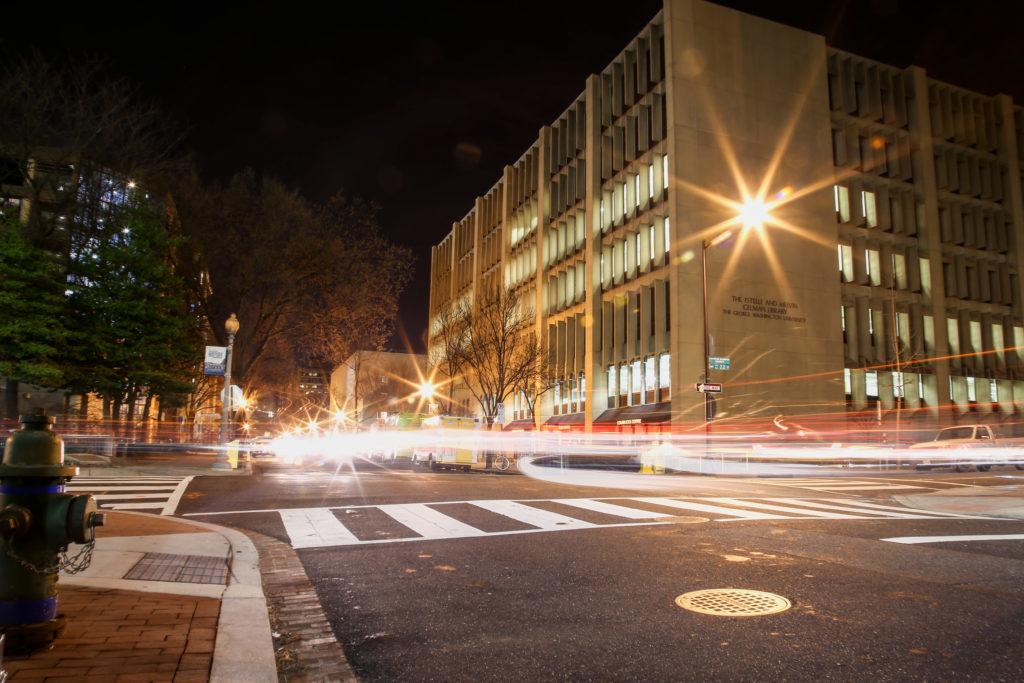Foggy Bottom is officially one of the worst traffic areas in the city.
Road congestion and travel-time unreliability place Foggy Bottom, grouped with the West End neighborhood, as the only neighborhood focus area in the District that need major improvements, according to a study by the D.C. Department of Transportation released earlier this month.
To fix Foggy Bottom’s traffic issues, DDOT officials will adjust traffic lights in the area and add additional bus and bike lanes, according to the study. Foggy Bottom and West End Advisory Neighborhood commissioners said these plans should reduce congestion from vehicles entering the city from the Whitehurst Freeway and Interstate 66 from Virginia.
The department also designated the Eastside Multimodal Crossing as a focus area, which goes across the Greenway and River Terrace neighborhoods.
Maura Danehey, a public affairs specialist for DDOT, said in an email that DDOT selected focus areas like Foggy Bottom based on the location’s mobility issues, including congestion, travel-time reliability and accessibility.
“Streets in this area can be uncomfortable without extra accommodation because of the high vehicular volumes and roadway configurations,” Danehey said.
Danehey said DDOT will consider adding bike lanes as necessary in the Foggy Bottom and West End neighborhood as part of a D.C.-wide plan to improve transportation ease.
DDOT completed traffic light timing adjustments in 2015 but plans to update them regularly as it receives newer traffic data from travel patterns, pedestrian needs and the impact of those initial improvements, she said.
“The signal retiming was performed in order to make traffic signals safer and more friendly to pedestrians and vehicles by updating all clearance times to meet the latest federal standards,” she said.
The study began after D.C. Council members requested to assess the District’s traffic issues to find ways to address specific congestion issues, Danehey said.
Foggy Bottom has low bus travel time reliability, high traffic and high stress for bike transportation, according to the study.
The study also named H and I streets in downtown D.C. a focus area because the region faces much of the same challenges as the rest of Foggy Bottom and West End, plus high bus ridership, overcrowding and low bus speeds. Road improvements, like constructing more lanes, are listed as proposed projects.
The department plans to equip buses with technology connected to traffic signals to lengthen green lights for buses. DDOT officials will make bus service accessibility a priority as well by adding bus lanes and removing on-street parking during peak travel hours, according to the study.
DDOT officials have considered adding a bus lane to H Street between New York and Pennsylvania avenues and bike lanes to Pennsylvania Avenue as part of a separate study that began in April.
Experts said they have noticed the neighborhood has more traffic than other neighborhoods around the District.
Former DDOT Director Gabe Klein said external travel from people coming and going to Georgetown and Virginia creates traffic in Foggy Bottom and students are not to blame.
“As much as possible, you want people to not drive, unless they need to,” Klein said. “The more people that don’t need to be driving, then the people who need to drive, can.”
Detrick Campbell, an ANC Commissioner and junior, said commissioners will wait to see what DDOT suggests for future plans after this study for Foggy Bottom and West End and depending on the solution, give their stamp of approval.
Although Campbell said adding more bike lanes would make it easier for bikers to navigate the streets, community members would need lessons on how to use the lanes because residents often illegally ride on the sidewalk instead of using bike lanes.
“Pedestrians are more prone to be on their phones and are not paying attention, and if someone’s reaction time is not fast enough it could be that someone gets hit and hurt, and we don’t want that,” Campbell said.
ANC Commissioner Marco Guzman said in an email that city officials should urge drivers to take alternative routes or transportation when they come from Rosslyn, Arlington or other close-by areas.
As the DDOT works on adding bike lanes on Pennsylvania Avenue west of the White House, Guzman said he will work to include bike lanes in Foggy Bottom’s future traffic projects.
“Providing the public with an open source for information on our city’s transportation system will hopefully lead to greater public awareness and better decision-making in the future,” he said.




